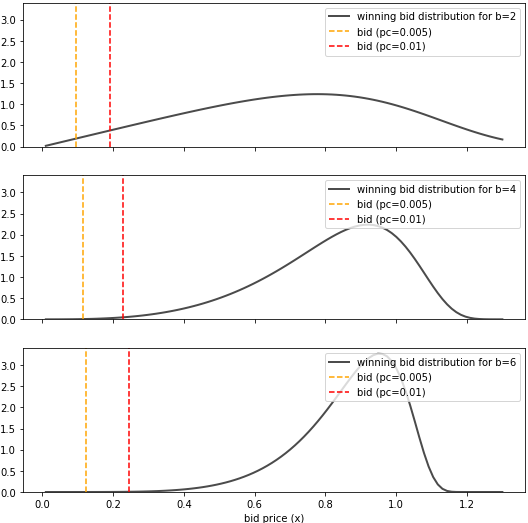Consider the case of participating in N ≫ 1 online ad auctions with a limited bidding
budget. The task is to create such a bidding strategy that you can win some of them, and
that the placed ads generate at least
The ad auctions can be put into several groups based on:
- the probability
$p_{ctr}$ that a user will click on the displayed ad if we win the auction - the probability
$p_{aucwin}$ to win an auction if we place a bid
The optimal bids for the different auction groups are obtained by the constrained optimization
problem where we have to minimize the expected spent budget
where
We assume that the number of auction groups
- Construct it directly from the winning-bids
$\lbrace s_i\vert i\in\mathcal{I} \rbrace$ from past auctions of this type ($\Theta(x) = 1$ if$x>0$ and$0$ otherwise):
- Use the cumulative distribution function of an analytical function for the distribution of winning bids
$p_{winbid}$ obtained, for example, through some variational inference approach:
A detailed description of the problem and the possible solutions is provided in this document.
The optimization problem is solved numerically 10 times and the best solution is used as a final result.
-
An example how to find the bid strategy for two auction groups with if we use analytical functions for the winning bid distributions is provided below:
PYTHONPATH=src python src/main.py optimize \ --n-click=100 \ --p-ctr='0.02, 0.02' \ --n='20_000, 10_000' \ --winbid-dist='[{"name": "exponpow", "params": {"b": 2}}, {"name": "exponpow", "params": {"b": 4}}]' \ --winbid-dist-analyticalWe have used the exponential power distribution to describe the winning bid distributions of both auction groups.
-
To solve the same problem by using samples of the winning-bids from past auctions, we first have to generate these samples:
PYTHONPATH=src python src/main.py generate-data \ --winbid-dist='[{"name": "exponpow", "params": {"b": 2}},{"name": "exponpow", "params": {"b": 4}}]' \ --save-path='data.json'The use these samples in the algorithm set
winbid-distto the path where the samples are stored ('data.json') and remove the--winbid-dist-analyticalflag:PYTHONPATH=src python src/main.py optimize \ --n-click=100 \ --p-ctr='0.02, 0.02' \ --n='20_000, 10_000' \ --winbid-dist='data.json'
More examples are provided in this Jupyter notebook and can be tested in this google colab notebook
The code used for the solution of the problem described in this blog post can be found in this release
